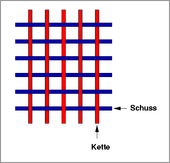Attachment doctrine
As binding teaching is referred to in the weaving teaching of the scheme of the possible crossing points of warp yarn (warp) and weft (weft) in woven fabrics.
Basic ties
The three basic weaves that belong to the systematically structured weaves with recurring weave repeats are as follows:
Plain weave
The plain weave is the most original and simplest type of weave that has developed from braiding . The weft goes alternately over and under the individual warp threads. Both sides of a plain weave fabric look the same.
Twill weave
In the twill weave, the weft goes under a warp thread, then over (at least) two warp threads, again under one, and so on. The next weft shifts this rhythm by one to the side (usually to the right) and one up. A typical diagonal pattern is created, which is called a twill ridge or diagonal ridge. The two sides of a twill weave look different. The side on which more warp threads can be seen is called the warp twill, the other correspondingly weft twill. The jeans fabric denim is always woven twill .
Satin weave
In the third basic weave, the satin weave (also known as satin weave), the weft goes under a warp thread, then over more than two warp threads, and so on. The next weft thread shifts this by at least two warp threads (usually to the right) and also up (usually by one). In this way, a fabric is created on which the parallel weft threads far predominate on the upper side, which gives the fabric a shine that depends on the incidence of light. The fabric is two-sided, and the warp threads predominate on the reverse side (as with twill weave, a distinction is made between warp atlas and weft atlas).
There are not many modifications of the atlas because the connection points must not touch. Two of these variants are the striped and the colored satin. A change between weft and warp atlas enables the fabric to be patterned (see damask ). The best-known atlas fabric is satin , which is why it is also referred to as satin weave .
presentation
The so-called binding cartridge is used to represent bindings .
Individual evidence
- ^ Paul-August Koch, Günther Satlow: Large Textile Lexicon: Specialized lexicon for the entire textile industry. Deutsche Verlags-Anstalt, Stuttgart 1965, vol.AK, p. 175.



